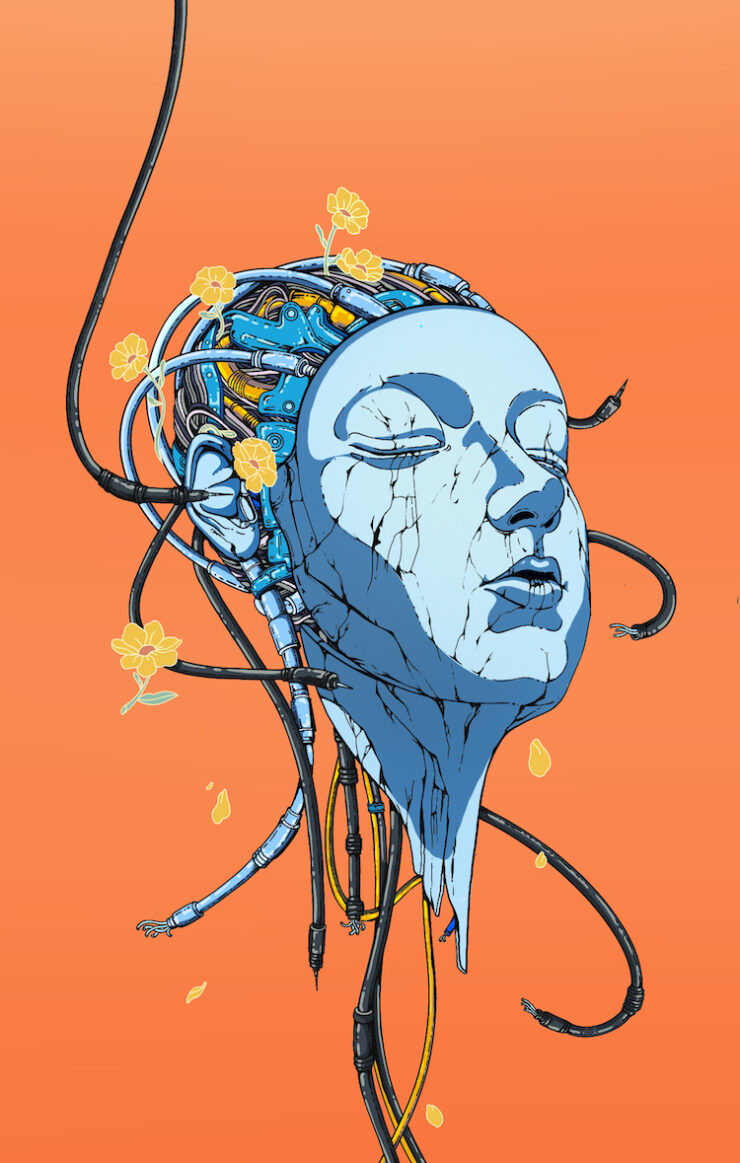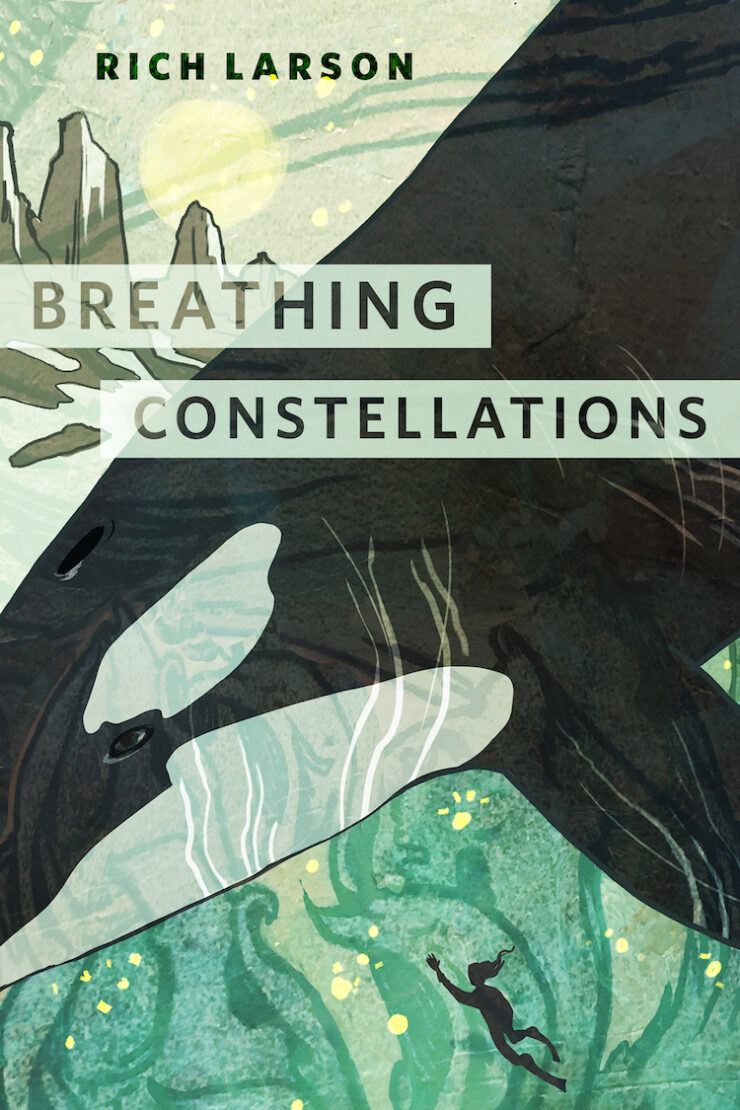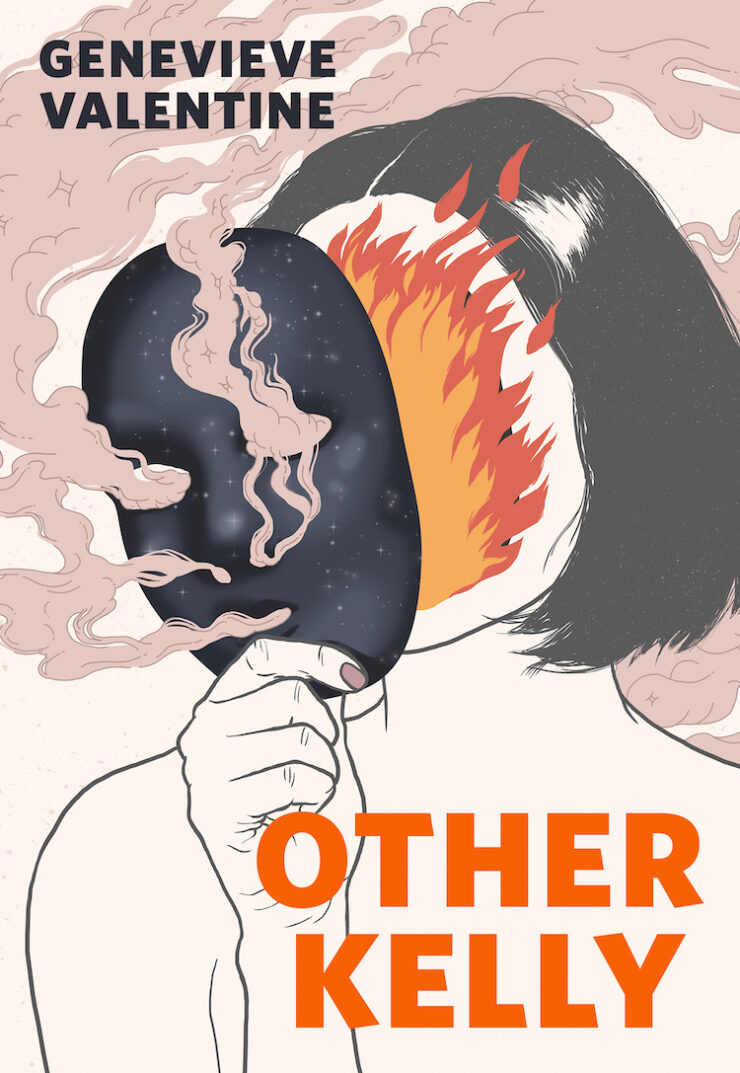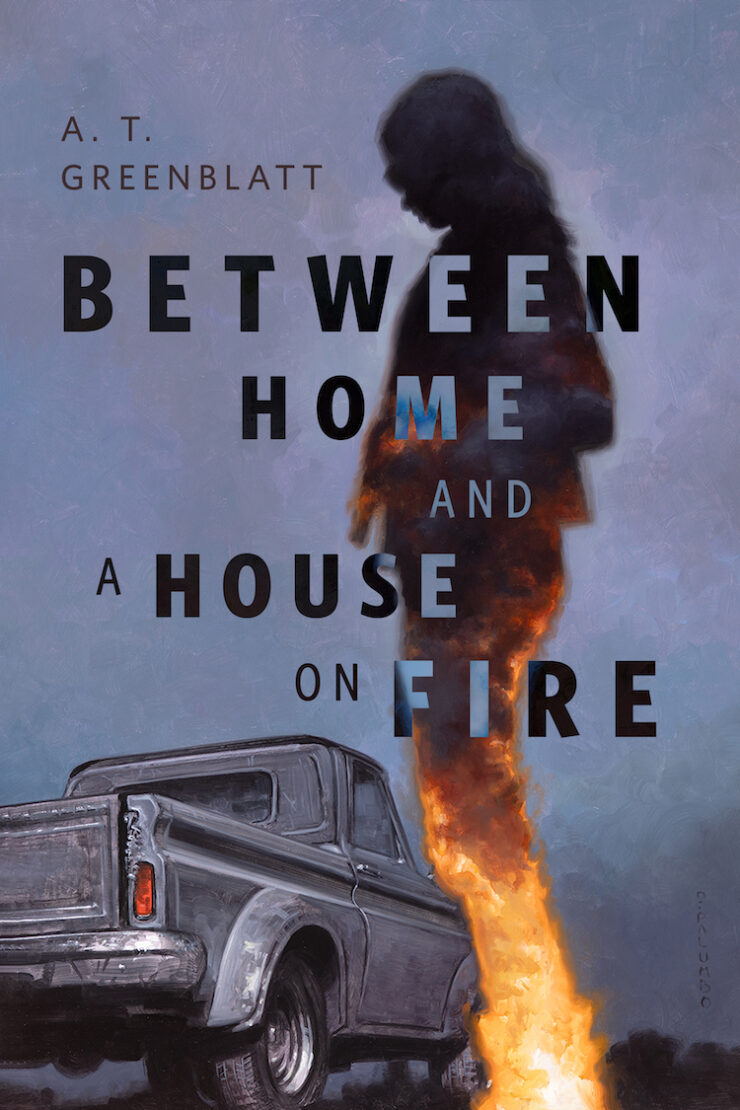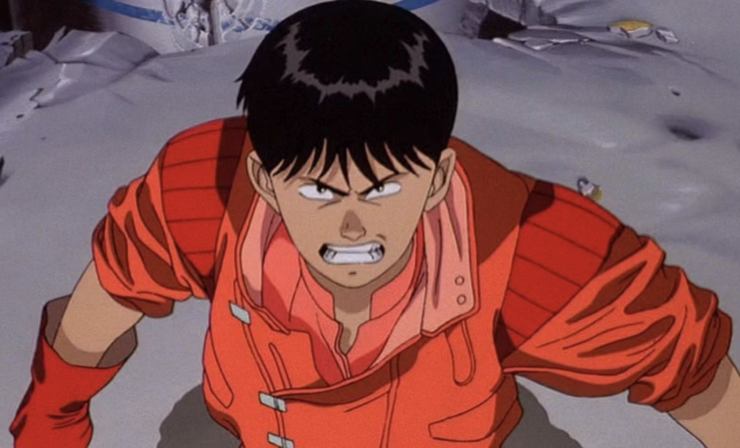Akira (1988) Directed by Katsuhiro Otomo. Screenplay by Katsuhiro Otomo and Izo Hashimoto based on Otomo’s manga Akira. Starring Mitsuo Iwata, Nozomu Sasaki, Mami Koyama, Taro Ishida, Tesshō Genda, and Mizuho Suzuki.
In her 1965 essay “The Imagination of Disaster,” Susan Sontag writes, “Science fiction films are not about science. They are about disaster, which is one of the oldest subjects of art.” She was talking specifically about the sci fi films of the 1950s and early ’60s, when movie theaters were filled with post-World War II films about invading aliens and rampaging monsters. We’ll watch a couple of those films next month (check the schedule below!), but Sontag makes one observation that I think applies to sci fi movies from all eras.
The science fiction film, she writes, “…is concerned with the aesthetics of destruction, with the peculiar beauties to be found in wreaking havoc, making a mess.”
Those words stick in my mind: the peculiar beauties to be found in wreaking havoc. If there is a better way to describe Katsuhiro Otomo’s 1988 animated film Akira, I don’t know what it is. It’s peculiar, it’s beautiful, and there is so much havoc.
It is also very much about disasters of the past, present, and future. But the sci fi movies of the ’80s were not the sci fi movies of the ’50s. The world had changed, and so too had the perspectives of both filmmakers and audiences.
Otomo began writing Akira in 1982 for a seinen (i.e. targeted at adult young men) manga magazine. He had already written several manga short stories when the publisher Kodansha approached him about writing for them. He repurposed some ideas from an unfinished previous manga called Fireball and started working on Akira. It was supposed to be about ten chapters long and take half a year. He had an outline and a plan and everything.
We all know how that goes.
Eight years later, in 1990, the story wrapped up with 120 total chapters. It was a success right from the start and only become more successful after the first tankobon volume was released in 1984. It remains wildly popular to this day—but you all know that already, because you’re sci fi fans and every otaku you’ve ever met will talk your ear off about Akira if you let them.
Among the manga’s early admirers was Archie Goodwin, an editor at the Marvel Comics imprint Epic Comics. Goodwin met with Otomo in 1983 and wanted to publish Akira for American audiences. Manga had been published for American audiences before, but the colorized version of Akira, which began its comics run in 1988, was the first manga to achieve real success in the United States. The story of how the manga was translated and adapted to American comic book format is interesting but, alas, largely off-topic for this article. But one cool thing to note is that Steve Oliff, the man who colorized the black-and-white manga, was among the very first comic artists to use computers for colorization, and his work on Akira (for which he won several awards) went a long way toward pushing the industry in that direction.
Otomo took some time away from writing the manga to make the anime, which he agreed to only under the condition that he maintain creative control. He got the creative control he wanted, but he came to regret agreeing to make the film before finishing the manga, largely because he felt like he had to cut too much in the film to tell the story. I have not read the manga, and I know the film makes significant changes to condense and adapt the story. I’m only going to talk about the story as it appears in the film. (But feel free to chime in on any interesting differences in comments!)
There has been animation in Japan for about as long as there has been animation anywhere in the world. There were definitely short animated films being made in Japan by 1917, but there is at least one animated clip that might have come from ten years earlier. But prior to WWII, Japanese animation was a fairly niche art form. Little of that work survives, in part because a great deal of it was lost in the 1923 Great Kantō earthquake (one of the deadliest earthquakes of all time). The Japanese animation industry didn’t begin building into the powerhouse it is today until after World War II, when there was a significant increase in films imported from the U.S. That included Disney’s animated movies, which helped inspire artists like “The Father of Manga” Osamu Tezuka. Animation studios began cropping up in Japan through the ’50s and ’60s, and in 1963 Tezuka’s Astro Boy became the first manga to be adapted into animation in the style and format we now know as anime.
In 1970s, there were animated shows all over Japanese television, and a great many of them were science fiction (such as Space Battleship Yamato and Mobile Suit Gundam). By the time we get to the ’80s, when Otomo started writing Akira, the Japanese animation boom was well underway, and soon there was a lot of everything from martial arts and sports to artsy high-brow works like Hayao Miyazaki’s Nausicaä of the Valley of the Wind (1984).
So it wasn’t unusual or unexpected when a group of entertainment companies approached Otomo about adapting Akira into a film. It is, curiously, the first anime film to use pre-scored dialogue, meaning the actors recorded their parts first and the characters are animated to match. There are some elements of CGI in the film, but for the most part the movie is over 160,000 cels of good old-fashioned hand-drawn animation.
I know I talk a lot about influence in this column. I do this because I am fascinated by all the ways works of art impact both audiences and other artists in different times and places, and I have decided to make that everybody’s problem by writing about it. In this case, it means emphasizing something that everybody who is even passingly familiar with anime and manga already accepts as a truism: it is difficult to overstate just how much of an impact Akira had on exposing anime and manga to worldwide audiences.
It wasn’t anywhere near the first, as there have been both manga and anime available and beloved outside of Japan since the 1960s. But Akira was a perfect storm of a story that appealed to a wide range of disaffected young people, offered high-quality and high-profile translations, and enjoyed the extremely lucky timing to become popular right at the start of a boom in home media, which meant that viewers could share their VHS copies around and force all of their college friends to watch the film.
So now that we’ve talked about Akira as a piece of media, let’s talk about it as a story, and specifically a science fiction story that imagines the future by looking at the past.
Japan in the 1980s was in the middle of a dizzying, unprecedented—and ultimately doomed—economic boom. It had recovered from WWII and grown to become one of the world’s largest economies. Through the ’60s and into the early ’70s, there had been several large protests, largely focused around opposing the United States-Japan Security Treaty that allows the U.S. to maintain military bases in Japan. But by the ’80s things were pretty stable: That unrest had largely faded (and the treaty remains in place today), Emperor Hirohito was in his fifth decade of rule, and the entire world was buying Japanese cars and electronics.
It was not exactly the sort of cultural and political environment one might expect would inspire the angry, messy, ultraviolent world of Akira. But inspiration is a funny thing, and Otomo has spoken about how he drew on those earlier restless, anxious aspects of life in Japan after WWII to create Akira. In a 2012 interview, he said, “Akira is the story of my own teenage years, rewritten to take place in the future.”
That future is the year 2019, but film opens in 1988 with the destruction of Tokyo in what appears to be a nuclear attack. We learn that World War III followed that attack, and the city of Neo-Tokyo has been rebuilt over the past thirty years. Now, if you’ll excuse me, I’m going to spend a little bit of time obsessing over the film’s opening act. Because it is, I think, one of the most vividly effective introductions to a fictional city that I have ever seen.
We meet Kaneda (voiced by Mitsuo Iwata) and Tetsuo (Nozomu Sasaki) and their bōsōzoku gang, a group of brash, aimless teenage assholes with customized motorcycles and an abundance of attitude. We just watched the entire city get destroyed in an explosion, but the scenes of these kids racing through the city, committing gleeful acts of senseless violence without a single care for who they harm or endanger, are in many ways so much more disturbing.
Part of that is because the animation is fantastic. (Remember: 160,000 animation cels! That’s so many cels.) The action is smooth and clean, the colors are vivid, the frenetic sense of momentum never lets up. But most of it comes from the fact that they really are just kids (we later learn they are still in high school) and only moments after meeting them we are treated to an extended demonstration of how very disconnected they are from their community and city—disconnected, even, from humanity.
While Kaneda’s group is clashing with a rival biker gang, others in the city are marching in a large demonstration. It seems to be a protest about tax reform, which sounds so very mundane until we see the hyper-militarized and extravagantly armed police force countering the protest. We know, as protesters around the world have always known, that when the cops bring that much firepower to a march, things are going to turn violent.
Meanwhile, right through the middle of the protest, a man and a child are fleeing in a panic. Two others, Ryu (Tesshō Genda) and Kei (Mami Koyama), are trying to catch up, but the man is gunned down. The child, Takashi (Tatsuhiko Nakamura), has a prematurely aged appearance and some freaky telekinetic powers; he escapes from the police and protest, only to run straight into the high-speed fight between the biker gangs. Tetsuo crashes his bike and is badly injured, but before his friends can figure out how to help him, the military shows up with another prematurely-aged child with telekinetic powers. They’re looking for Takashi, but they also take Tetsuo with them.
What I love about this entire opening sequence is how well it sets up the story we’re about to explore in this futuristic city. The motorbike ride provides a street-level perspective as intersecting threads of story reveal more of the city. Violent gangs abound, but it’s not a lawless place; the police deploy their immense firepower against political protesters. The military can vanish children from the streets and not care that witnesses watch it happen. The city has rebuilt since it was destroyed thirty years ago, but there is still a crater at its center with the ruins of the old city around it. The damage is still there.
The military subjects Tetsuo to painful experiments that bring out psychokinetic powers (as well as some extreme emotional volatility and a few extra psychological problems). The men in charge think Tetsuo has the potential to be as powerful as their last star experimental subject, the mysterious Akira, who was responsible for the destruction of Tokyo thirty years ago. Tetsuo escapes the hospital just long enough to find his friends again before being recaptured. After that, Kaneda joins with Kei and her anti-government resistance group to locate him. But Tetsuo escapes again to look for Akira, leading to the film’s climactic showdown at Neo-Tokyo’s unfinished Olympic stadium.
While the opening of the film provides a breakneck and expansive introduction to the city, the climax draws all of the characters together in this singular and highly symbolic arena. We’ve already seen the corrupt officials of the unstable authoritarian government talk about how they’ve finished rebuilding from the war and it’s time to build for the future. (Is there anything governments do that says, “You should ignore all of our problems because we’re doing just super and everything is great!” more obviously than hosting the Olympics?) We’ve seen a military coup, but we’ve also seen the military utterly fail to deal with a superpowered teenager they themselves created.
And we’ve seen that the source of the original destruction, another child from another era, never went anywhere either. He’s still right there in the city, dissected and frozen and buried beneath that Olympic stadium that is meant to represent everything bright and hopeful about the future.
Because the damage is still there. All of it, it’s still there. That’s the key to the heart of the story. This is a world that inflicts terrible wounds on its young people and refuses to learn any lessons from how they fail to heal. Tetsuo is a disregarded and mistreated orphan; the only family he has to miss him are Kaneda and the rest of their gang. Their society was failing its children even before the military snatched Tetsuo off the street to turn him into a weapon, and it failed them over and over again when that experiment went badly.
The “peculiar beauties” of destruction are so vividly on display here at the end, when Tetsuo is overcome by a grotesque transformation. Nobody does body horror like Japanese animation does body horror, and the result is fascinating and repulsive in equal measure. Tetsuo’s transformation is clear: what you get when you try to brutally reshape a child into a weapon is a monster you cannot control.
And that’s a tragedy. It was a tragedy before it even began, and it was never going to be anything but a tragedy, because all of the adults in Tetsuo’s life who could have changed it or stopped it instead kept twisting an angry, violent boy into an angrier, more violent version of himself.
Science fiction films, like horror films, are often representative of the particular fears and anxieties of the time and place in which they were made. We saw a very specific and obvious form of this in the post-WWII paranoia of The Day the Earth Stood Still (1951) and in the tension between good and evil uses of science in The Mysterians (1957), and we’ll definitely see it some more when we watch Godzilla (1954) in a couple of weeks. In so many postwar sci fi movies there is a thematic element of, “We must learn from our mistakes or else.”
And here is Akira, emerging from the garish extravagance of the 1980s, offering a particularly vivid or else: or else we’ll just keep doing the same thing over and over again.
One of the things Otomo has said about writing the manga is that he wanted to show a post-apocalyptic world decades into its reconstruction. So many post-apocalyptic stories entertain fantasies of the immediate aftermath and a slate wiped clean, or of a future far enough removed that the world has effectively been rebooted.
But living in the world never feels like that. Living in the world feels like constantly trying to recover from the mistakes of the past while making brand-new mistakes for the future. There are always old men arguing in circles about blame and credit. There are always soldiers who protect one group of children by firing upon another. There are always young people whose anger and violence are disdained right up until they become useful to somebody in power.
That’s what Akira understands so very well. There is never a clean slate. There isn’t a future in which we all get to start over with perfect moral clarity and a selection of easy choices. It’s always going to be messy, muddled, and difficult. And that, I think, is one of the main reasons Akira slammed into audiences with its wicked cool motorcycle slide and has never really let up.
What do you think of Akira’s vision of the future? Anybody have thoughts on what was left out from the story for the film adaptation? Are you upset with me for picking so many depressing movies for this month? Don’t worry, we’re changing gears next month…
Give It Up for Wet Hot Kaiju Summer…
Or winter, if you’re in the southern hemisphere. I love giant monsters. You love giant monsters. We all love giant monsters. Let’s have some giant monsters. This was very difficult to narrow down, but I’ve picked a mix of classics and modern takes. These films are all pretty widely available online, so I’m not making you hunt down any sketchy internet bootlegs this month. (You’re welcome.)
July 3rd – The Beast from 20,000 Fathoms (1953), directed by Eugène Lourié
A dinosaur attacks New York. I don’t know what else to tell you. What more could you possibly want?
Watch: Amazon, Apple, Google, Vudu, YouTube, Microsoft.
Here’s the trailer.
July 10 – Godzilla (1954), directed by Ishirō Honda
A Japanese movie producer saw the above film and thought, “We also want a giant lizard monster guy.” A legend was born.
Watch: Max, Roku, Criterion, Tubi, Amazon, Vudu, Apple, and more.
Here’s the trailer.
July 17 – Trollhunter (2010), directed by André Øvredal
Nobody actually likes hot weather, so let’s go to the mountains of Norway and hunt some trolls.
Watch: Amazon, YouTube, Hoopla, Vudu, Tubi, and so many other places, seriously, this one is free everywhere.
Here’s the trailer.
July 24 – The Host (2006), directed by Bong Joon-ho
Or we can dump some toxic chemicals in the Han River. I’m sure nothing will go wrong.
Watch: Amazon, Hulu, Roku, Hoopla, Kanopy, and many other places because I am making it so easy for you this month.
Here’s the trailer.
July 31 – King Kong (1933), directed by Merian C. Cooper and Ernest B. Schoedsack
We’ll end where it all began, with the King of the Beasts.
Watch: Max, Amazon, Apple, Google, YouTube, Vudu, Microsoft.
Here’s the trailer.
[end-game]


